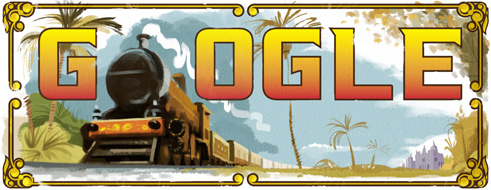
April 16, 2013 marks the 160th anniversary of India's first passenger train journey in which 400 invited passengers travelled in 14 carriages on a 57 minute journey from Bori Bunder in Bombay (now Mumbai) to Thane.
Since that first journey in 1853, railways have have become one of the most important modes of transportation in the country. Here's a look back at the early days of Indian railways in a series of photographs from the 19th century.
A train carying livestock passes Rohtas Fort, India, circa 1851. The area is now part of Pakistan. Original Publication: Illustrated London News, pub. 7th June 1851 (Photo by Illustrated London News/Hulton Archive/Getty Images)
12th March 1864: Two storied, third class carriage on the Bombay, Baroda and Central India railway. Original Publication: Illustrated London News - pub. 1864 (Photo by HultonArchive/Illustrated London News/Getty Images)
circa 1867: An Indian station near Calcutta. (Photo by Hulton Archive/Getty Images)
A railway crash on a bridge in India. (Photo by Hulton Archive/Getty Images)
circa 1880: A railway reversing station on the Bhore Ghat Incline, near the town of Poona or Pune in Maharashtra on the edge of the Western Ghats. Pune is the junction point for two railways from Bombay (now Mumbai) to Madras (now Chennai). (Photo by Hulton Archive/Getty Images)
A railway reversing station on the Bhore Ghat Incline, near the town of Poona or Pune in Maharashtra on the edge of the Western Ghats, circa 1880. Pune is the junction point for two railways from Bombay (now Mumbai) to Madras (now Chennai). (Photo by Hulton Archive/Getty Images)
circa 1880: A view of the Scinde Delhi and Punjab Railway, a few miles from Lahore, looking towards Meean Mir on the plains of Punjab in Northern India (modern day Pakistan). (Photo by W. Harris/Hulton Archive/Getty Images)
A train derailment during track-laying in India. (Photo by Hulton Archive/Getty Images)
circa 1890: Passengers waiting on the platform at Hyderabad Station in India. (Photo by Hulton Archive/Getty Images)
A view of Victoria Station, Mumbai (Bombay), circa 1900. Built in 1888 to a design by Frederick William Stevens, it is now known as the Chhatrapati Shivaji Terminus. (Photo by Hulton Archive/Getty Images)
-=======================================================================--WHAT IS AMUSING IS THAT IT TOOK ABOUT AN HOUR MORE THAN 150 YEARS AGO;AND IT STILL TAKES AN HOUR IF NOT MORE TODAY!!! .SHOWS INDIAN RAILWAYS PROGRESS IN 150 YEARS
WHILE THE DOODLE DEPICTS PALM TREES ,ALL WE SEE TODAY ARE REMNANTS OF OLD FACTORIES ;UGLY NEW HIGH RISES,
NOW SCENERY BELOW
Siddeshwar Talao in Thane
UNFINISHED SKY WALKS ,AND OPEN AIR TOILETS
THEN

KURLA STATION BOMBAY(MUMBAI) 1853
.WHILE PEOPLE TRAVELLED COMFORTABLY SITTING INSIDE ,NOW IT IS
NOW
NETAS DONT CARE FOR COMMON MAN
Mumbai's rail lifeline a death trap for commuters - CNN.com
Jul 23, 2007 – On average, 4,000 people die a year on Mumbai's railways, crushed ...His office fined about 30,000 people $12 each last year for breaking ...
Mumbai's rail lifeline a death trap for commuters
On average 4,000 people die a year on Mumbai's railways, crushed under trains, electrocuted by overhead power lines or killed as they lean from jam-packed ...
-------------------------------------------------------------------------------------------------------------